
Barrier-Free in the Bathroom – the Elderly-Friendly Bathroom
A senior-friendly or disability-friendly bathroom enhances the level of independence and possibilities for home care significantly. In many cases, even highly restricted individuals can continue living at home without having to move into a nursing home.
In the best case, thanks to some adjustments, those affected can use their bathroom completely independently again. A senior-friendly bathroom definitely makes home care by relatives or nursing services much easier.
Being able to wash and care for oneself in old age, as well as managing toileting independently, builds self-confidence and preserves dignity. Therefore, it is recommended to plan your own accessible bathroom before reaching retirement age.
Here is an overview of all topics covered in this article. By clicking on each line, you can directly jump to the section you want to read:
- Basic conditions of the senior-friendly bathroom
- How to facilitate the use of the toilet?
- How to make the shower safer and more comfortable?
- How to make bathing relaxing and enjoyable despite disabilities?
- Adapting the bathroom to be barrier-free
- Wheelchair users in the bathroom
- Converting bathtub to shower cabinet
- Entrances and doors for bathtubs
- Adapting the toilet
- Adjusting the sink
- Solving space problems and planning ahead
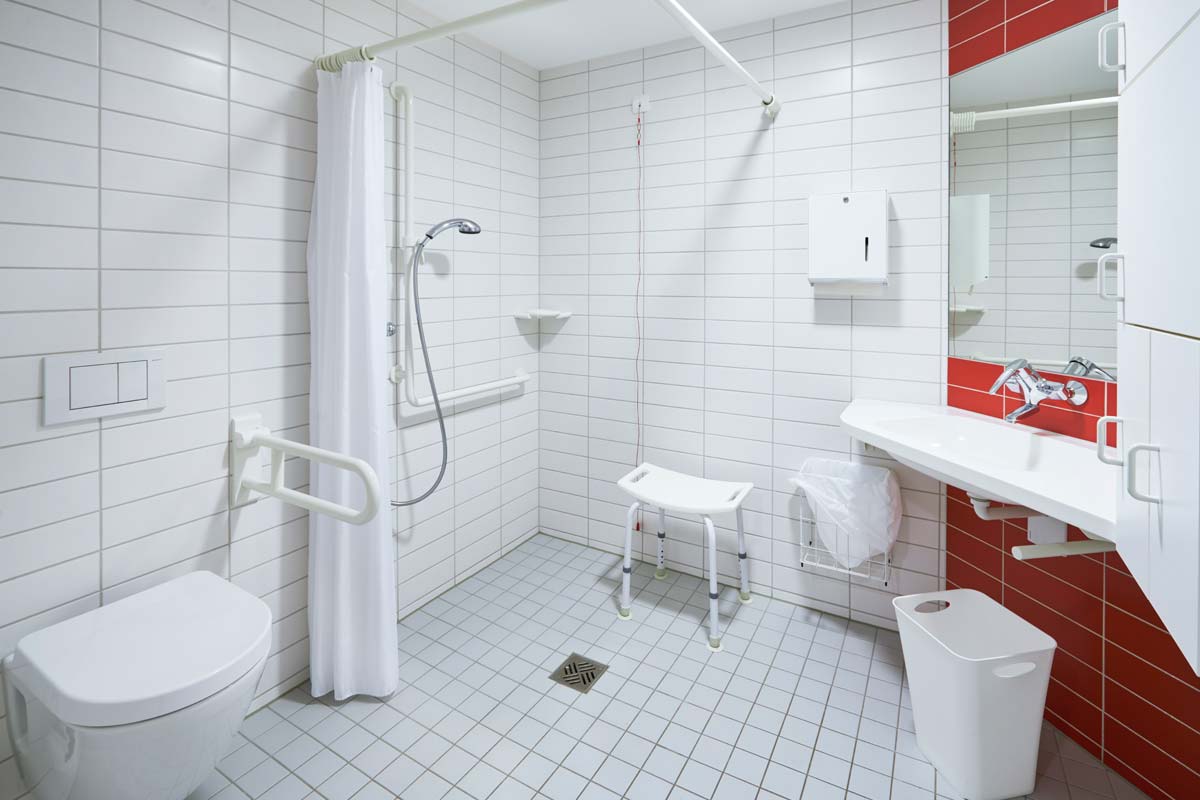
Basic conditions of the senior-friendly bathroom
First and foremost, every senior-friendly bathroom should offer sufficient space. Age-related stiffness makes many movements awkward, requiring arms and legs to stretch further. Mobility aids such as walkers or wheelchairs need ample space to maneuver and navigate. Therefore, a senior-friendly and barrier-free bathroom should ideally be large enough to accommodate wheelchair entry and turning.
Safety is the next major consideration. Falls are among the most common home accidents in old age, with bathrooms posing higher risks due to wet spots on tiles. Getting in and out of the bathtub or using the toilet without aids also requires some strength and coordination.
Anti-slip aids ensure safe walking and standing in the bathroom. Non-slip mats can be placed in showers and tubs. Bathroom carpets should also have non-slip bottoms to prevent slipping when wet. Seating options like shower chairs or stools not only make personal care more comfortable but are also secured against slipping.
Even on solid surfaces, those with balance issues can still sway. Handrails accessible at all times on walls provide a secure support. Grab bars are also advisable at toilets, sinks, and anywhere else needing support.
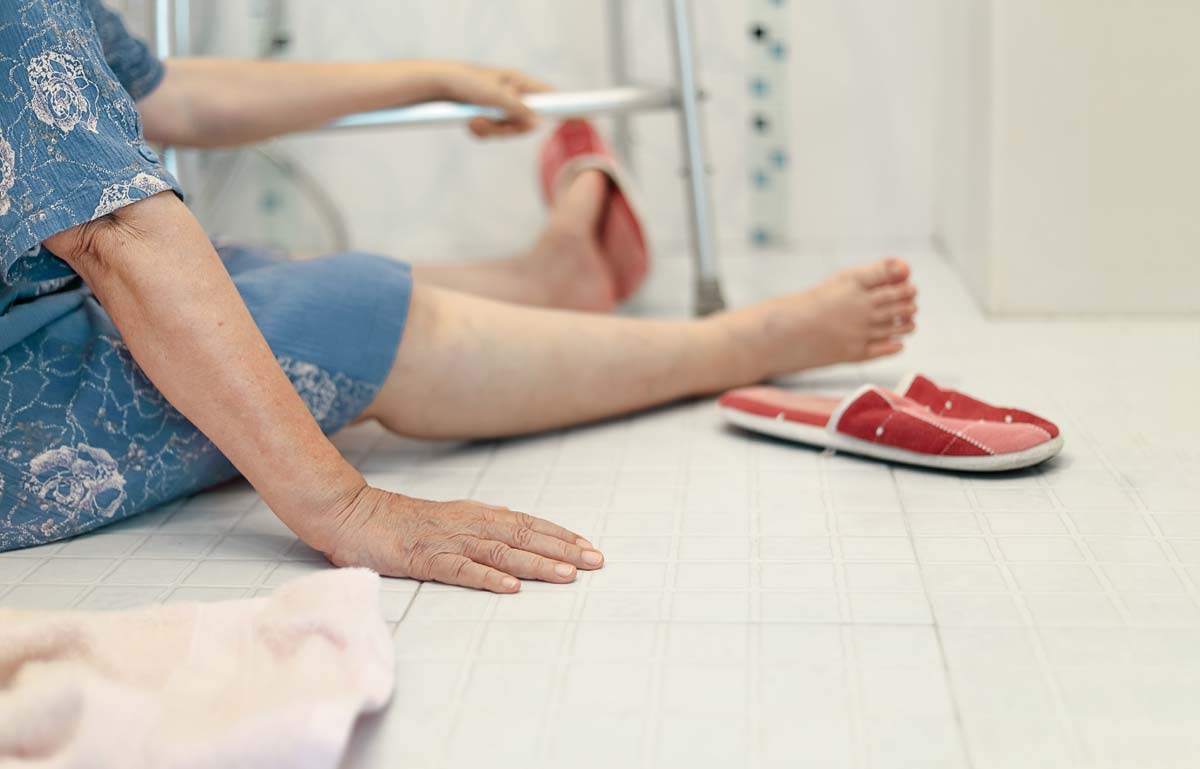
Furthermore, it's important to remove all obstacles for a tidy bathroom where everything is safely stored. For people with visual impairments, it's crucial that everything has a designated place to avoid accidental knocks.
It should be clear that glasses and other fragile decorative items have no place in a senior's bathroom. To minimize injury risk, rounded furniture, basins, and fixtures are recommended over sharp edges. It hurts less to bump into a round surface.
How to facilitate the use of the toilet?
The use of the toilet under restricted physical conditions can be significantly facilitated by using various aids.
A toilet seat riser is simply placed on top of the regular toilet, allowing for a higher seating position. Seniors can then sit almost from standing height on the toilet without needing to bend down deeply. Such seat risers also have the advantage of being easily removable and replaceable when someone else needs to use the toilet.
Using the toilet should generally not take excessive time, as sitting for too long can disrupt blood flow to the legs due to the pressure of the toilet seat. What is not a problem for young, healthy people can become problematic for older people with venous disorders. Therefore, toilet seat risers are usually made of soft, yielding materials.
Toilet seat risers are available with or without lids, or as toilet seat risers with armrests.
A simple alternative, if a seat riser is not needed, is a padded toilet seat. Made of soft plastic, these toilet seats allow for comfortable sitting and fit on all standard toilets.
What if a solution for toileting is needed outside the bathroom? In both care homes and households with multiple caregivers, it is common for the bathroom to be occupied. In addition, conditions such as incontinence may require a toilet to be readily available nearby.
Toilet chairs are the ideal solution and should be provided accordingly. Users can sit on a toilet chair much like a regular chair, but with a cut-out seat where a toilet pail is anchored. Toilet pails can be quickly replaced after use, while the seat surface is easily disinfected – the toilet chair is ready for use again in no time.
A toilet wheelchair goes – or rather, rolls – even further, as it moves freely on wheels. This can even be done while it is being used if necessary.
The simple alternative to a toilet wheelchair – especially interesting for hospitals and nursing homes – is a portable support frame for toilet pails.
Toilet pails are usually available separately with handles and lids and can also serve as a bedside commode in emergencies. The lid helps contain odors if you can't empty it right away.
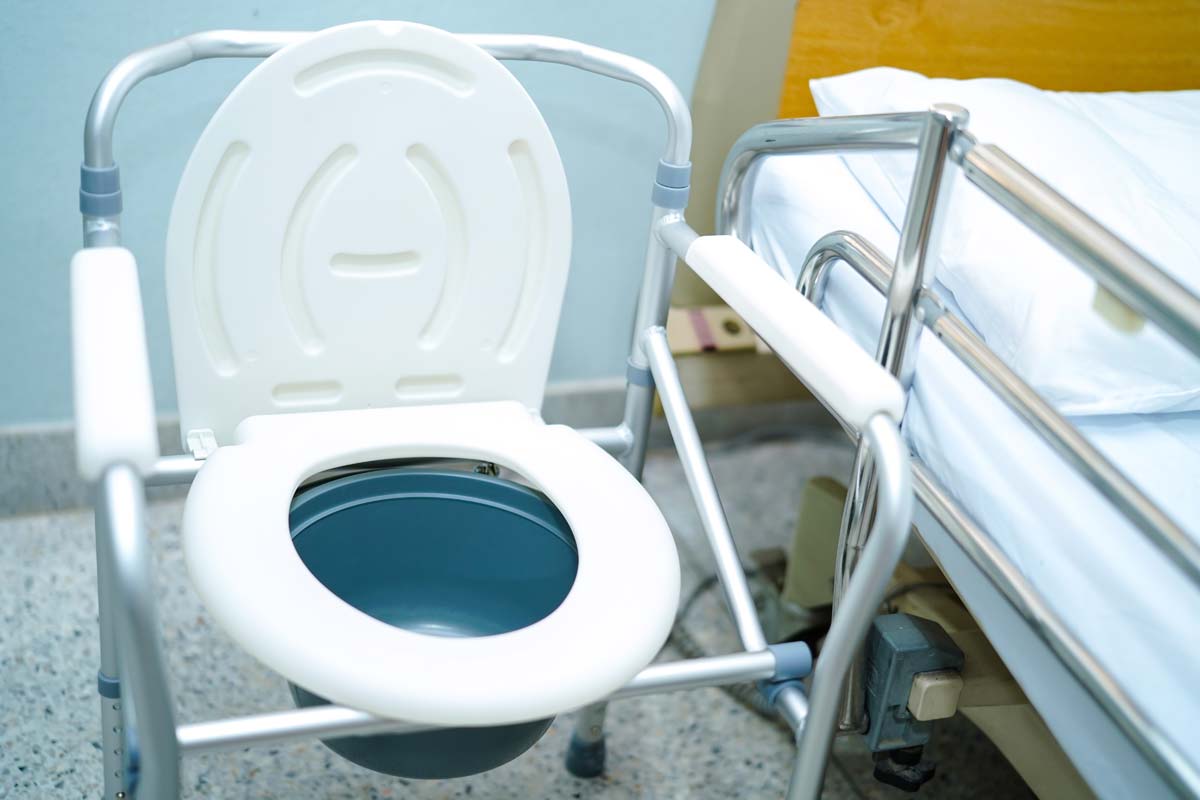
By the way, any standard toilet can be converted into a simple bidet basin for sitz baths or intimate area cleaning. These plastic basins are attached as inserts to the toilet bowl and can be sterilized in an autoclave.
How to make a shower safer and more comfortable for seniors?
In a standard shower, one typically stands to shower. However, standing on a wet surface poses risks for elderly individuals with balance issues or reduced strength. A fall onto the hard floor could lead to severe injuries like a dreaded hip fracture. Ideally, the shower tray should be inset into the floor, leveling the shower floor with the bathroom floor so there's no threshold to step over when entering.
Several simple aids significantly enhance safety, even in showers that aren't fully barrier-free.
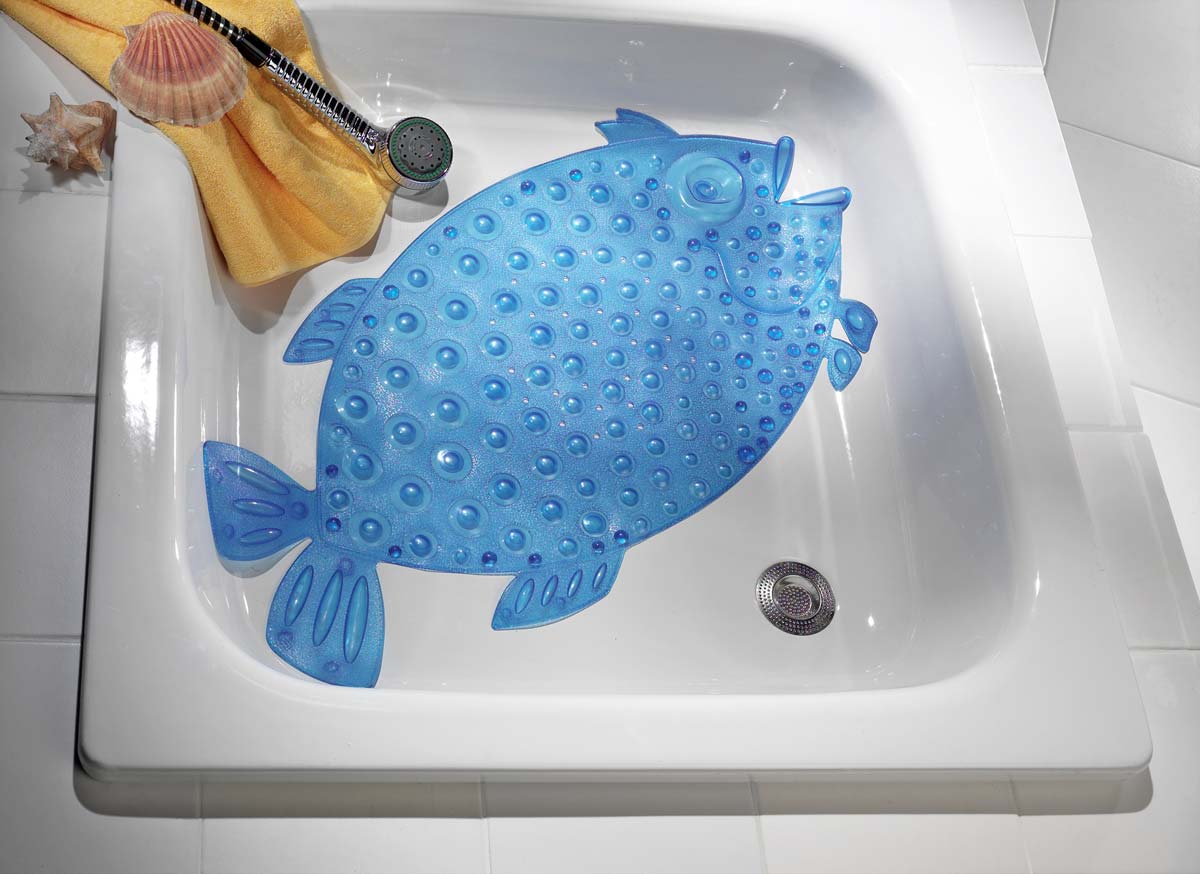
Safety shower mats are made of non-slip materials like soft rubber or thermoplastic elastomer (TPE). Many models feature bumps or grooves on the surface to enhance stability. These mats securely attach to the shower and bathtub with suction cups on the underside. Unlike older fixed adhesive anti-slip mats, modern safety shower mats can be easily removed for cleaning from all sides. Some TPE mats are even machine washable.
Grab bars are available in various designs for showers, bathtubs, or wall mounting in other bathroom areas. It's important to choose high-quality materials like stainless steel or impact-resistant plastic, with surfaces offering high grip – such as textured surfaces with bumps or ridges for fingers.
Shower stools provide stable seating directly in the shower. Rubber anti-slip feet keep the stools securely in place even when water is flowing. Adjustable height models can be tailored to the user's height. Most shower stools are adjustable in height multiple times. If you want to make a small or narrow shower cabin safer and more comfortable, placing a shower stool inside is a good option.
In the caregiving sector, shower stools with integrated swivel seats are particularly useful. The caregiver can stand outside the shower and rotate the patient on the stool with minimal effort. This makes caregiving much easier, especially for larger or more robust individuals.
In addition to simple stools, there are also shower chairs available with armrests and backrests. While these chairs offer more comfort, they usually require more space than a simple stool. Extremely space-saving are fold-down shower seats, which can be securely mounted on the wall. When needed, they fold out like a cinema seat. Of course, a fold-down shower seat can also be installed in other rooms of the house as a space-saving seating option.

Shower wheelchairs are water-resistant caregiver wheelchairs with soft wheels that can be pushed into floor-level showers along with the patient. Combination solutions such as toilet chairs and shower wheelchairs like the mobile shower and toilet wheelchair from Behrend are ideal for highly dependent patients.
Don't rely solely on individual bathroom aids presented here. Combine mats, grab bars, and possible modifications to achieve maximum safety and accessibility.
How can bathing be relaxing and enjoyable despite a handicap?
Bathing should be a relaxing experience without causing strain. However, it becomes challenging when simply getting into the tub poses a risk due to lack of strength or stiff joints.
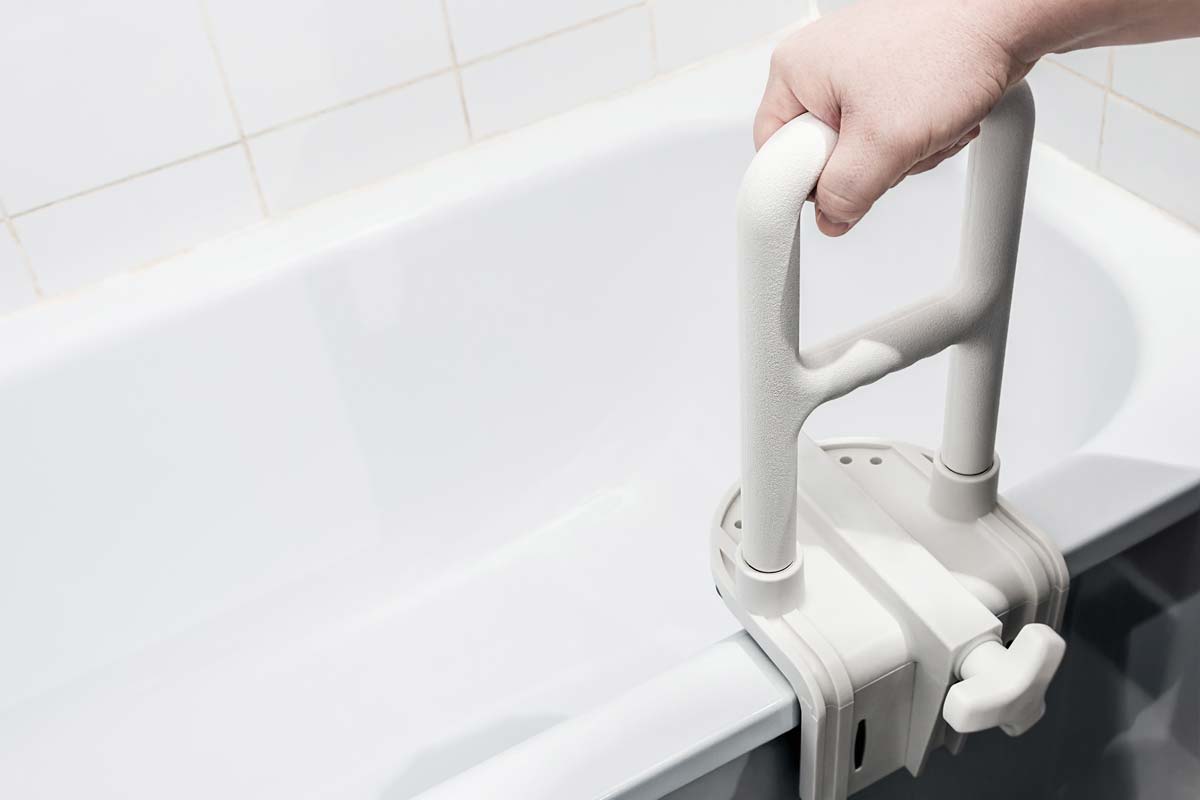
Various aids and grab bars for bathtub and shower make entering the tub easier and safer. Entry aids often consist of tubular constructions that are attached to the bathtub rim. Adjusting screws and rubber covers keep the support frame securely in place.
To reduce the entry height into the bathtub, bathtub steps or steps can be attached to the outside. Bathtub steps are non-slip pads that can often be adjusted to the preferred height.
Swivel lifts are the optimal solution for wheelchair users, as they securely lift and lower the user into the tub. However, these are complex and not inexpensive constructions. Either way, a secure seating position in the bathtub must be ensured. A bathtub lift or inflatable bath cushion can be used to raise the bathing person's seating height, preventing them from sliding underwater. Similar to lift chairs, these aids are also useful for getting out of the tub. An inflatable bath cushion, for example, can lift a patient further up by further inflating the cushion.
The simpler solution for secure seating in the bathtub is the bathtub seat. Adjustable in width, such a seat can be hung in tubs of any size.
For more comfort and better access by caregivers, swivel bathtub seats can also be used.
When bathing, weakened individuals are at risk of slipping and submerging underwater. A bathtub shortener helps to support themselves. This aid is securely held in place with suction cups. The sturdy board can also be adjusted in its distance, allowing the feet to comfortably lean against it. Naturally, it is also suitable for smaller individuals or children.
To prevent elderly bathers or those in need of care from hitting the back of their heads, safety headrests can be attached to the head end of the tub. These head or neck rests are made of soft materials such as TPE plastic and are held in place by suction cups. During bathing, the head can comfortably lean against it.
Various modifications can further facilitate the use of the bathtub – more on that a bit further down.
Making bathrooms barrier-free – what options are available?
Bath and shower aids facilitate the use of the bathroom and its sanitary facilities. However, especially with more severe physical limitations, it is advisable to have the entire bathroom converted to be senior-friendly or handicapped-accessible. Wheelchair users face challenges in non-accessible bathrooms that people with healthy legs don't have to think about.
Example: Wheelchair users in the bathroom
The hurdles for wheelchair users begin with reaching the sanitary facilities. Fortunately, many residential buildings now have spacious elevators, and public buildings are equipped with wheelchair ramps. Wheelchair-accessible toilets are also available in offices, schools, and offices, as well as at train stations, airports, etc. The real problems arise when using bathrooms that are not adapted for the disabled.
Oftentimes, there's no space to comfortably maneuver the wheelchair through the door or to place it next to the toilet. The sink is too high to wash hands properly while sitting.

Additionally, there should be no cabinets beneath the basin to allow space for a wheelchair to be maneuvered close enough. Otherwise, wheelchair users would have to lean forward or attempt to lift themselves up to reach the sink.
Viewing oneself in the mirror above the basin is only possible in a wheelchair if the mirror can tilt. The operating device must also be mounted low enough. The shower can only be used with entry aids and must have specific seating options for wheelchair users. Ideally, wheelchair-accessible showers can accommodate shower wheelchairs.
Toilet paper, towels, or grooming products like soap and lotions should be within reach while sitting. However, shelves, cabinets, and storage surfaces are usually placed too high.
Many of the problems described here can pose obstacles even when visiting friends. Of course, the availability of wheelchair-accessible bathrooms also limits the job choices of wheelchair users.
All these bathroom problems can be avoided if the space is appropriately renovated. At least the home bathroom should be made barrier-free. Wheelchair users can usually receive contributions from nursing care funds for their costs.
Bathrooms can also be designed to be used equally by physically restricted and unrestricted individuals.
Many plumbing installers offer conversion solutions and have the necessary experience for barrier-free bathrooms. Some companies even specialize in bathroom renovation. Simply inquire with businesses in your area. Find out in advance whether you need permission to renovate your premises.
Convert the bathtub into a shower cabinet
If the bathtub is completely removed, the resulting space can be used for a floor-level entry shower cabinet. Take advantage of such a barrier-free bathroom conversion to also have the shower modified for caregiving.
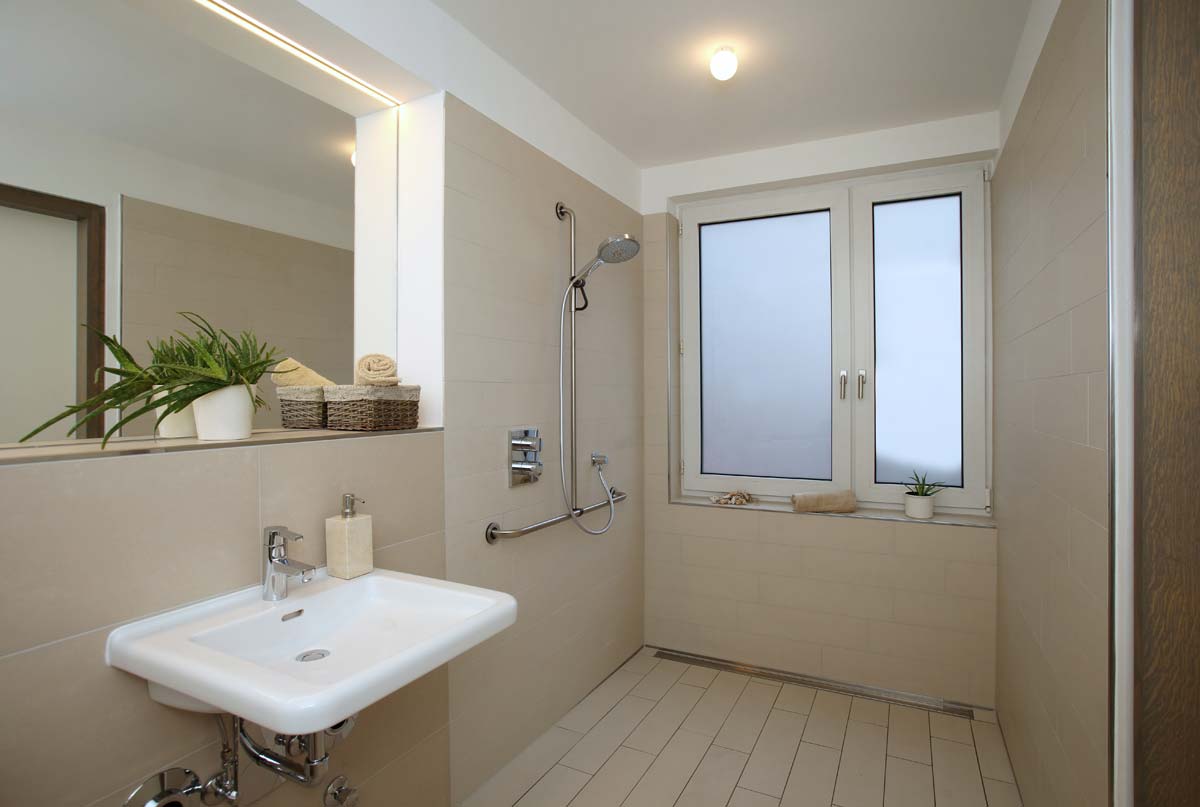
This way, the shower floor can be equipped with a non-slip coating. Seating options such as folding seats or a footrest to assist with washing can be installed directly. Also, consider having a conveniently accessible towel holder in the shower – you shouldn't walk across the room with wet feet to get a towel.
Fully glazed shower cubicles with shower doors also facilitate the work of caregivers. They can assist with personal care from outside the shower without getting soaked. The transparent cubicle is made of plastics or safety glass.
For barrier-free accessibility, minimum dimensions must be observed for the shower area. For example, according to DIN standards, a shower must have a free area of at least 1.5 by 1.5 meters to be usable with a wheelchair.
The floors of walk-in showers are slightly lowered to prevent water from spilling into the rest of the bathroom. Old showers with raised shower trays can also be converted to be suitable for seniors and barrier-free.
Install doors and entries for bathtubs
If a bathtub is to remain, it can be modified for seniors by installing doors or entries. Installing a door in an already installed bathtub is quick and easy. The lower the entry height of the door, the more comfortable the later entry will be. Bathtub doors are sealed absolutely watertight. One small drawback: the bathwater can only be filled after entering with the door closed.
Bathtub doors represent an excellent compromise to make the tub usable for both restricted and unrestricted individuals.
An entry into the bathtub without a door can also be chosen. This option is certainly cheaper and makes the tub easier to enter. However, it then becomes suitable only for showering and no longer for bathing.
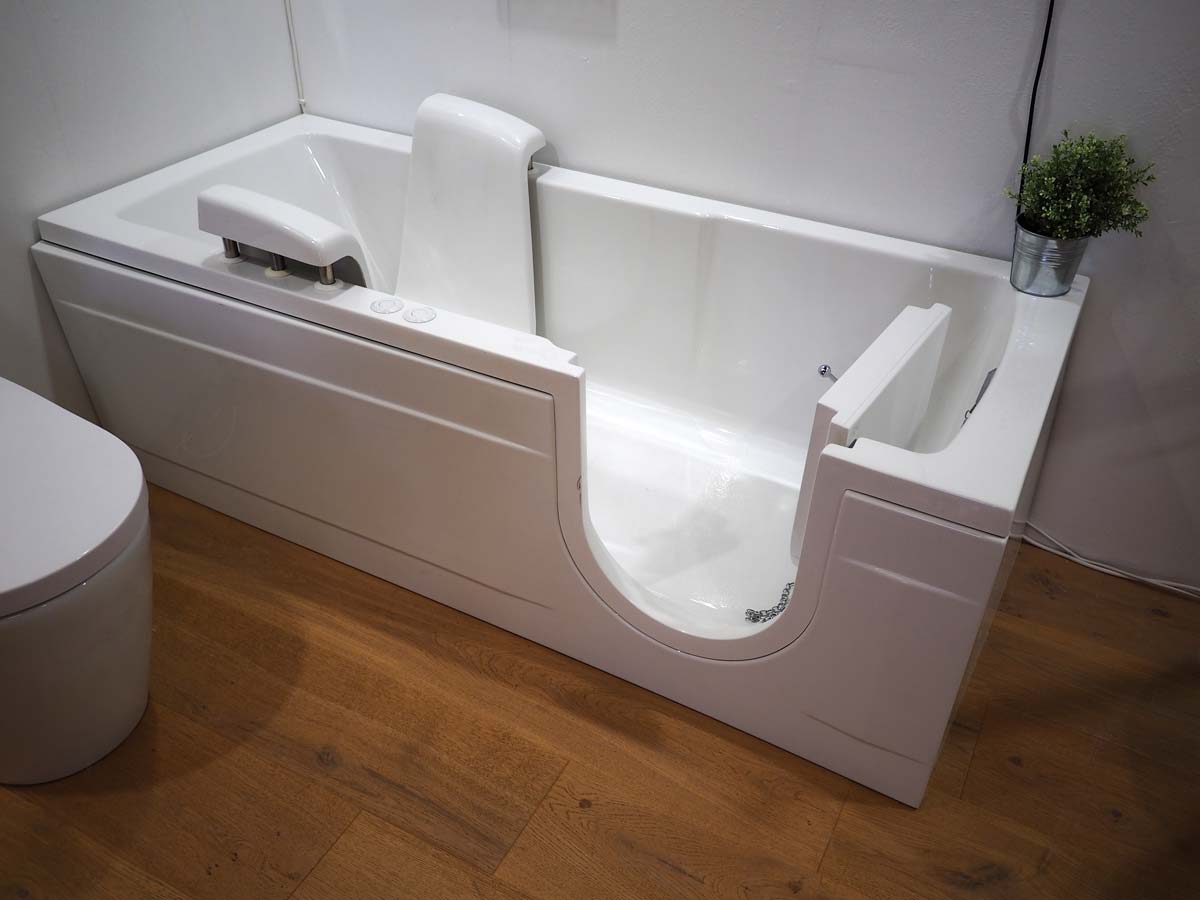
Sit-Down Bathtub
A sit-down bathtub includes a permanently integrated bench or at least a seat depression. This allows bathers to sit securely and comfortably, eliminating the need for standing while performing personal care.
Toilet renovation
Most toilets are relatively low – usually less than half a meter high. Consider having a wall-mounted toilet installed at a higher position. This allows you to sit comfortably in old age and requires only a very short distance when getting up. However, keep in mind that a wall-mounted toilet cannot be raised to a new height later without tearing down the entire wall.
Naturally, the previously described seat raisers offer a cost-effective alternative and can also be flexibly adjusted later. Furthermore, grab bars can be anchored to the wall next to the toilet.
A bidet toilet seat with a water jet is extremely practical and hygienic as it automatically cleans the anus with a water jet. Such special toilets usually also have dryer nozzles, which dry the buttocks afterwards. This eliminates the need for labor-intensive wiping with toilet paper.
Of course, a bidet toilet seat must also be thoroughly cleaned. Although water showers and nozzles are hidden under protective covers, dirt can accumulate at their edges.
Adapt the sink to specific needs
The sink must be securely positioned. Above all, it should be avoided for users to lean directly on the basin. For this purpose, it is advisable to install support handles on the sides of the sink.
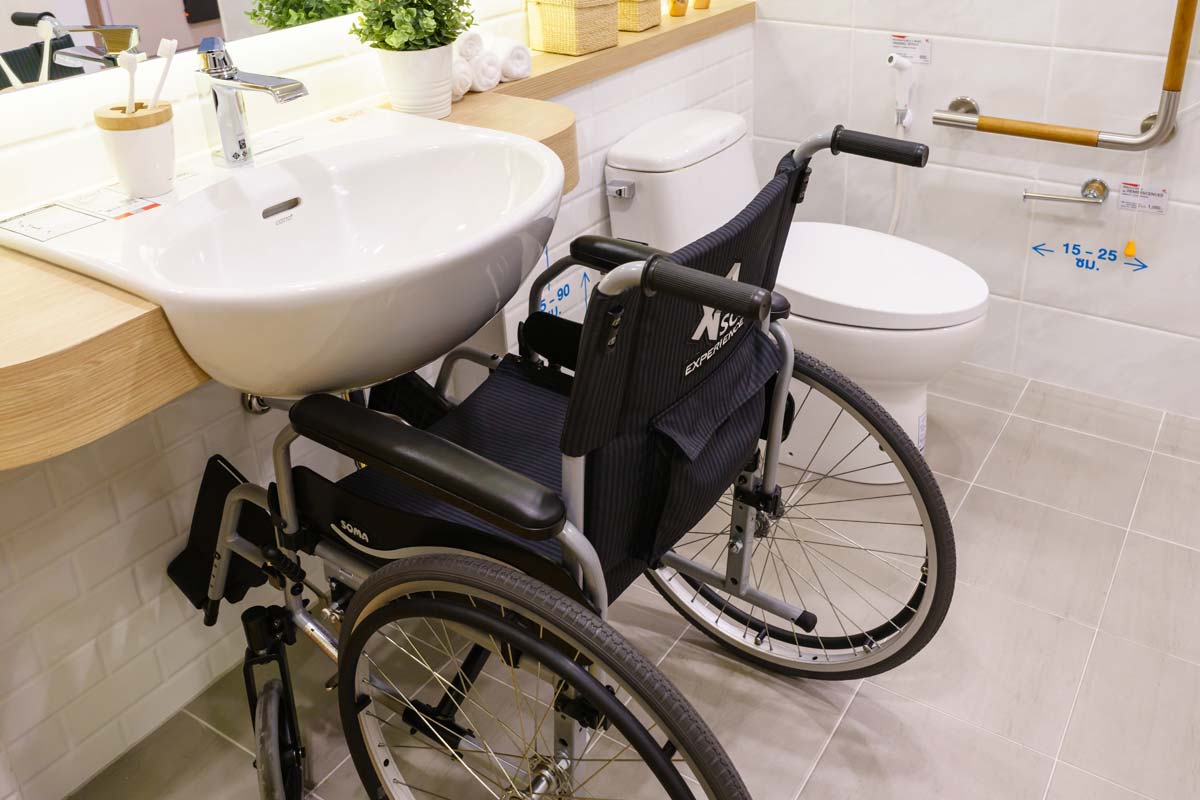
Lever handles are better than old-fashioned knobs, which can sometimes be very stiff. With a lever, water temperature and flow rate can be controlled single-handedly, leaving the other hand free to grip a grab bar. For wheelchair users, sinks must be installed lower. The space under the basin must be clear.
Resolving Space Issues
Small bathrooms can be problematic. However, even with only a few square meters available, conversion solutions can be found. You should reduce what can be reduced and remove all furniture and objects from the room that are not truly necessary.
If the building structure permits, the sledgehammer method can also be chosen to create wall breakthroughs or merge rooms. There are certainly specialized construction companies and plumbing installers for this comprehensive renovation of the bathroom area. It is also advisable to obtain necessary official permits.
Timely Planning for Senior-Friendly Bathrooms
It is best to plan for senior-friendly renovation long in advance. Even if retirement is still several years away, planning should begin for bathroom renovations and improvements at a certain age. It is advisable to design the home bathroom so that it can be easily converted to be senior-friendly when needed.
After all, it is almost impossible to predict when and in what form the first signs of aging will appear.
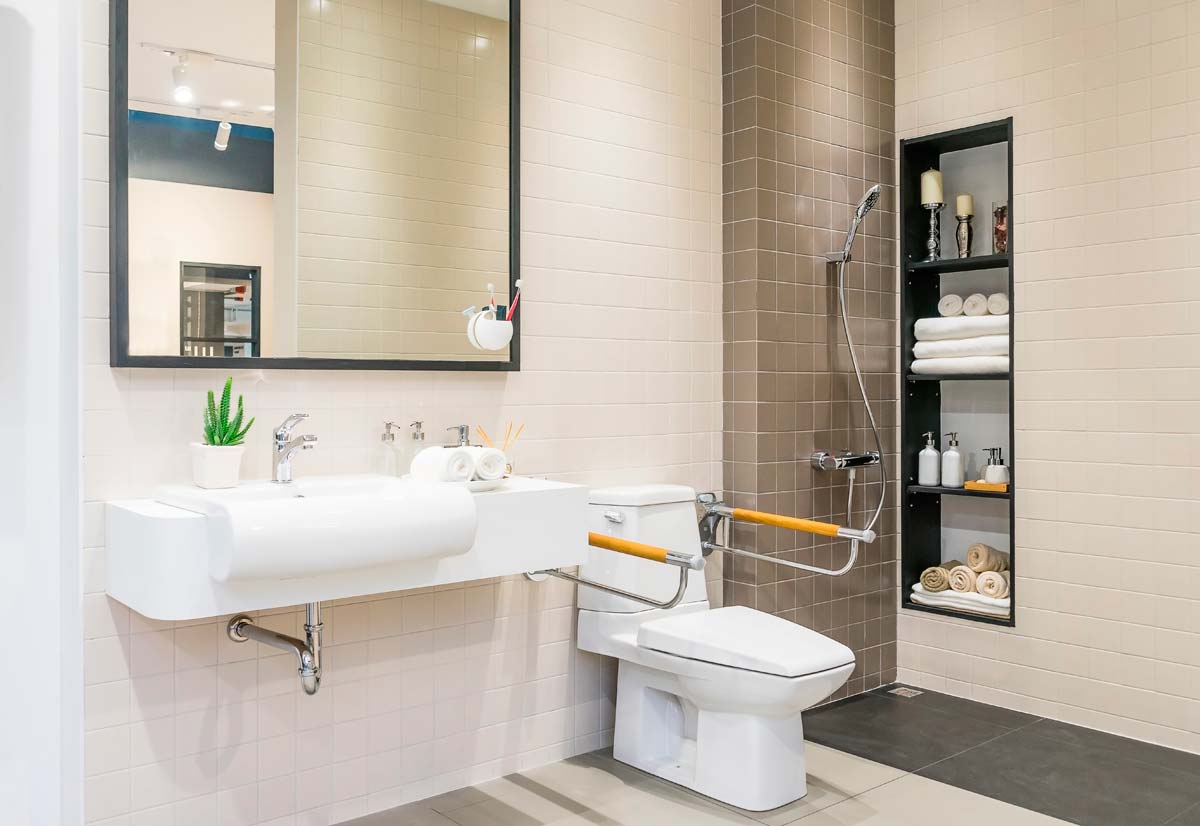
Applying for Funding for Bathroom Renovation
If you have a disability or age-related ailments and possess a care level, you may be able to get a good portion of the costs for bathroom renovation reimbursed by the care fund.
Since extensive bathroom renovation can be very expensive, we recommend checking if you can receive funding for it.



